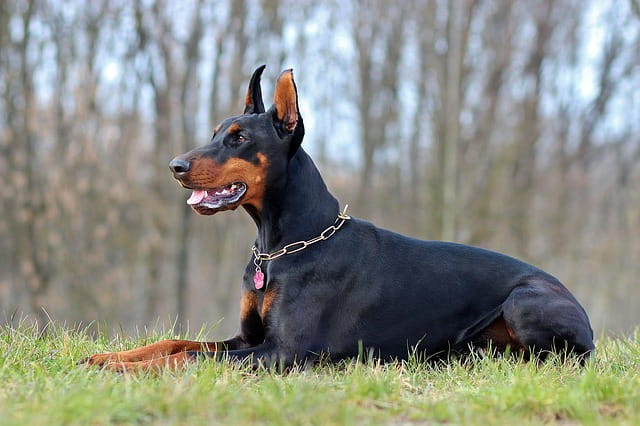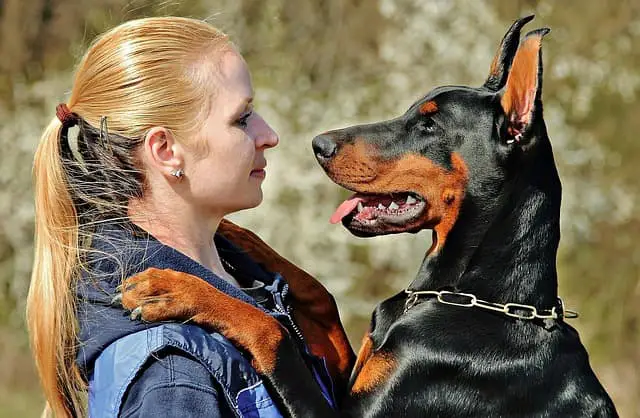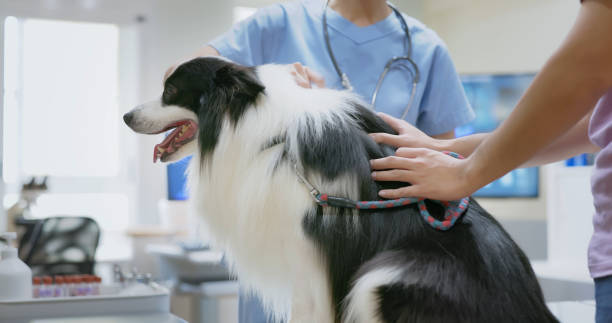In the vast world of canines, there is a remarkable diversity of breeds, each with its unique characteristics and qualities. Among them, the Border Collie and Doberman Pinscher stand out as captivating breeds.
While both dogs possess exceptional traits and make excellent companions, they differ significantly in terms of appearance, temperament, and purpose. In this comparative analysis, we delve into the distinctive features of Border Collies and Dobermans, shedding light on their origins, physical attributes, temperaments, and roles within human society.
By understanding their similarities and differences, we can gain a deeper appreciation for these breeds and make informed decisions when choosing the perfect furry companion for our lives.
Characteristics of Border Collie and Dobermann
The Border Collie breed emerged in the border region between Scotland and England, specifically designed for the purpose of herding and managing sheep in the hilly terrain. Renowned for their intense gaze, known as the “eye,” these dogs possess exceptional control over their flock. Their boundless energy, stamina, and unwavering work ethic establish them as a top-tier herding dog, and they continue to be utilized worldwide for sheep herding on farms and ranches.
On the other hand, originating in Germany during the late 19th century, the Doberman Pinscher primarily served as a guard dog. While their precise lineage remains uncertain, they are believed to be a blend of various dog breeds, including:
- Rottweiler
- Black and Tan Terrier
- German Pinscher
This breed exudes an aristocratic aura with its sleek coat, athletic physique, and dignified appearance. Not only are they highly energetic, but they also possess remarkable intelligence, enabling them to excel in roles such as police and military work, canine sports, as well as serving as loyal family guardians and companions.
| Border Collie | Dobermann | |
| Weight | Male: 30 to 45 pounds
Female: 30 to 42 pounds |
Male: 65 to 90 pounds
Female: 65 to 90 pounds |
| Male | 22 inches | 26 to 28 inches |
| Female | 20 inches | 24 to 26 inches |
| Ears | Upright | Floppy |
| Exercise | Must commit at least 30 minutes of exercise daily | Must commit at least 30 minutes of exercise daily |
| Energy Level | High | High |
| Life Span | 10 to 14 years | 10 to 12 years |
| Tendency to Drool and Snore | Low | Low |
| Barking Tendency | High | Low |
| Digging Tendency | Low | Low |
| Social/Attention | Moderate | Moderate |
| Bred For | Herding | Guard |
| Coat Length | Medium | Short |
| Grooming Needs | Moderate | Low |
| Recognition | Recognized both by UKC and the AKC as a herding breed | Recognized as a working dog and a guardian dog by AKC and UKC respectively |
History of Breeds
The Border Collie’s roots trace back to the early days of human-dog collaboration in Britain. Shepherds in the border region between Scotland and England relied on these dogs to safeguard and herd their sheep. The breeding process involved selecting the finest working dogs, resulting in variations based on specific regional needs and terrain.
As a result, these dogs with exceptional herding abilities became known by various names, including Welsh Sheepdogs, Northern Sheepdogs, Highland Collies, and Scotch Collies. The term “collie” originated from Scottish dialect, emphasizing the breed’s Scottish heritage.
The story of the Dobermann begins with Louis Dobermann, a tax collector residing in Apolda, Germany, during the late 19th century. Due to the perilous nature of his job, Dobermann sought protection during his rounds, combining his duties as a dogcatcher with his desire for a loyal companion and guardian. Through careful breeding, he developed the early Doberman Pinscher, a breed renowned for its loyalty, companionship, and protective instincts.
Appearance Differences

Border Collies are beloved for their endearing characteristics, including their elegant feathered tail that extends to the hocks and their jaunty ears, which stand erect but feature tips that gracefully fold over. In contrast, Dobermans boast a distinctive appearance characterized by their elongated heads and sleek, muscular bodies. Their ears are commonly cropped to stand upright, and their tails are typically docked to a shorter length.
Size Comparison
When it comes to size, Border Collies and Dobermanns have their distinguishing characteristics. Male Border Collies can reach a height of up to 22 inches and weigh around 45 pounds (20 kilograms), while their female counterparts stand at approximately 21 inches tall and weigh up to about 42 pounds (19 kilograms).
Male Dobermans typically have a height ranging from 27 to 28 inches and weigh about 70 pounds (32 kilograms). Female Dobermans, on the other hand, are slightly shorter and weigh approximately 60 to 65 pounds (27-29 kilograms).
These variations in size provide a distinct physical difference between the two breeds, with Dobermanns generally being larger and heavier than Border Collies.
Coats & Colors
Border Collies display two coat variations: rough and smooth. The rough coat is of medium length and features feathering, while the smooth coat is shorter and has less feathering. They are available in a range of colors, including black with a white blaze and tan markings. Dobermans, on the other hand, possess a sleek, short coat and can be found in colors such as black, red, blue, and fawn, often accompanied by distinct rust markings.
This combination of a short and smooth coat with specific color patterns and markings gives Dobermanns their characteristic appearance.
Personality & Temperament
Border Collies are active and intelligent working dogs that thrive in rural or country settings. They require ample physical exercise and mental stimulation to lead fulfilling lives. Without regular activity and companionship, Border Collies may become unhappy and exhibit destructive behaviors. This breed is known for its exceptional intelligence, quick learning abilities, and responsiveness to positive reinforcement. They have a strong desire to please their owners and excel in various training activities.
On the other hand, Doberman Pinschers are renowned for their people-oriented nature, displaying affection and sweetness towards their human companions when properly socialized and trained. They are loyal to their owners and can be good with children if raised together. However, it’s important to note that some Dobermans may form a stronger bond with only one person. Developing a positive and consistent relationship through socialization, training, and attentive care is crucial to nurturing a well-rounded and loving Doberman Pinscher.
Family and Border Collies vs Dobermann

Border Collies are known for their herding instincts, which translate into a protective nature towards their family and territory, making them excellent watchdogs. They are attentive and look out for the well-being of the family, especially children.
While they generally get along well with children and other pets they have been raised with, Border Collies can display reserved and occasionally snappish behavior towards strangers. This behavior is reminiscent of their herding instincts, as they instinctively nip at the heels of sheep to control their movement.
In contrast, Dobermanns are a large and powerful breed that thrives on being actively involved in their owners’ lives. Their loyalty and intelligence make them popular pets, particularly because of their adaptability to different family dynamics.
While originally bred to be guard dogs and often trained by armed forces and police as working dogs, Dobermanns can integrate well into family life with the guidance of an experienced owner. They are well-suited to active families who can provide ample space for them to burn off energy and engage in play. With their versatility and adaptability, Dobermanns become cherished members of the right family environment.
Kids
When comparing the Border Collie and the Dobermann, both breeds can make great additions to a family. However, there are certain factors to consider for each breed. The Border Collie is a suitable family dog, but it requires proper upbringing and early training.
On the other hand, the well-bred Dobermann can also be an excellent family dog. This breed is known to be trustworthy and protective of the children in their family, provided they have been properly socialized and trained. It is crucial for children to treat the Doberman with respect and kindness, as they will reciprocate the same level of affection and loyalty.
Other People
When comparing the Border Collie and the Dobermann, their behavior towards strangers differs. Border Collies tend to exhibit reserved behavior, often requiring socialization from an early stage to prevent potential fear or aggression towards unfamiliar individuals or animals. To foster their comfort and confidence in new situations, it is crucial to expose them to positive experiences with different people and animals.
Conversely, due to their historical role as guard and police dogs, Doberman Pinschers have gained a reputation for being perceived as intimidating and potentially aggressive towards strangers. This can be attributed to a combination of anxiety, fear, and their innate instinct to protect their territory.
Dogs & Other Animals
In terms of their interactions with other dogs and animals, there are notable distinctions between the Border Collie and the Dobermann.
Border Collies, by nature, may not immediately exhibit friendliness towards other dogs. Their strong herding instincts, which have been preserved through generations of selective breeding, are deeply ingrained and difficult to suppress. Even as pets, Border Collies tend to display behaviors that can hinder their compatibility with other dogs, making it necessary to put in effort to foster harmonious relationships.
Conversely, Dobermanns generally exhibit a more amiable disposition towards other dogs and animals within their household, particularly if they have been raised alongside them. However, caution should be exercised when introducing them to unfamiliar dogs outside of their immediate family. Dobermanns can display aggression towards perceived threats to their loved ones, which may manifest in interactions with other dogs.
Behavior Issues
Border Collies, known for their high energy and intelligence, require proper exercise and mental stimulation to prevent destructive and obsessive behaviors. Over-exercising can also lead to negative outcomes. With natural herding instincts, Border Collies may inadvertently nip at adults, particularly young children, causing fear and concern. They may also exhibit a desire to herd cars.
Dobermans, on the other hand, have a strong affinity for working alongside people, but this can make them prone to separation anxiety. Insufficient activity exacerbates this anxiety, resulting in excessive barking and destructive chewing.
Training & Exercise of Border Collie and Dobermann
The Border Collie is renowned for its exceptional intelligence and is a breed that responds well to training, especially with experienced handlers. To ensure successful training, it is crucial to commence positive, reward-oriented training from a young age and maintain this approach throughout the Collie’s life.
These dogs often display a genuine enthusiasm for training sessions and demonstrate a remarkable ability to grasp new commands promptly. Participating in training classes that offer more advanced commands can be highly beneficial for them.
Similarly, Dobermanns are also highly intelligent and possess a strong desire to learn, making them receptive to ongoing, reward-based training that helps stimulate their active minds. For individuals who are first-time owners or have limited training experience, seeking guidance from a certified trainer and enrolling their Dobermann puppies in training classes is strongly advised.
It’s worth noting that Dobermanns, although highly intelligent, may exhibit a slightly stubborn nature during training, necessitating a consistent and firm yet fair approach from their owners.
Taking Care & Maintenance Comparison
The Border Collie is an extremely energetic breed that thrives when actively engaged with its owners. They are well-suited for households that embrace an active lifestyle and have experienced owners. Although they may not be the ideal choice for first-time owners, those with prior experience will find Collies easy to train and eager to please. Similar to most dog breeds, Collies prefer constant companionship and can become troublesome if they are bored. In such situations, they will make their discontent known by resorting to destructive chewing of anything within their reach.
In contrast, Dobermanns flourish in lively households where they can be involved in every aspect of daily life. With proper training, they can exhibit a calm and composed demeanor, despite their larger size.
Dobermanns possess a strong desire to learn and should be provided with an environment that keeps them mentally stimulated, as failing to do so may result in furniture and garden casualties.
Grooming

When it comes to grooming, Border Collies are relatively low-maintenance. While they do shed, especially during the spring and autumn seasons, it is not as excessive as in some other breeds. Regular brushing a couple of times a week is usually sufficient to manage the shedding and maintain their coat’s condition.
Occasional baths may be necessary for Collies. It is important to use a suitable dog-friendly shampoo and consult with your veterinarian if unsure about the right product to use.
Whereas with Dobermanns, it has coats that are also low-maintenance. Their short fur only requires brushing once a week to keep it in good condition. Although they do shed, it is significantly less than longer-coated breeds, making them a popular choice for many owners.
During the spring and autumn, you may notice a slightly increased shedding, prompting more frequent brushing. Baths for Dobermanns are generally only necessary if they have rolled in something unpleasant. Considering their larger size, it might be beneficial to opt for professional assistance when giving them a bath.
Shedding
When it comes to shedding, Border Collie dogs have a moderate shedding level. Shedding is a natural process in their hair growth cycle. Regular brushing helps minimize the amount of hair that is shed. The extent of shedding can vary depending on the individual dog’s health and specific breed characteristics.
Similarly, Doberman Pinscher dogs also have a moderate shedding level. Shedding is a normal part of their hair growth cycle. Regular brushing is beneficial in controlling the amount of hair that is shed. The extent of shedding can be influenced by factors such as the dog’s overall health and breed type.
Health of Border Collie and Dobermann
While the Border Collie is generally considered a healthy breed, it is still important to be aware of certain health issues that may affect them. Regular check-ups with your veterinarian are crucial to ensure the overall well-being of your Border Collie. By staying proactive and scheduling regular vet visits, you can catch any potential health issues early on and provide appropriate care to maintain your Border Collie’s health and quality of life.
On the other hand, Doberman Pinschers are known for being generally healthy dogs. They have a relatively low incidence of breed-specific health problems compared to some other breeds. While they are generally robust and resilient, regular veterinary check-ups are still essential to monitor their overall health and well-being. Fortunately, due to their overall good health, the veterinary costs associated with this breed are often reasonable and manageable.
Life Span
When comparing the lifespans of Border Collies and Dobermans, it is evident that both breeds have different average life expectancies. Border Collies typically live between 10 and 17 years, although the majority tend to reach around 12 years old. On the other hand, the average lifespan of a Doberman is about 10 to 12 years.
This information is crucial to consider when deciding to adopt a younger or older dog of either breed. Additionally, it is important to note that families with young children should opt for a Doberman puppy. This decision is significant as it entails a potentially challenging conversation with the children as they grow older.
Diet & Nutrition
When it comes to the Border Collie, it is important to establish a consistent feeding routine. This breed typically requires two meals per day, consisting of approximately .75 to 1 cup of dry dog food per serving, depending on the individual dog’s size and activity level.
Additionally, it is crucial to ensure a fresh and clean water supply for your Border Collie. As your dog ages, its nutritional needs will change, so it is essential to monitor its weight closely. If you observe weight gain, consulting your veterinarian is recommended to create an appropriate plan of action. Adjustments in feeding schedule, type, or quantity of food may be necessary. Providing sufficient daily exercise is equally important for this naturally energetic breed.
With a Dobermann, these dogs requires a slightly different feeding regimen. Offering two smaller meals throughout the day is preferable, with a total of up to three and a half cups of dry dog food per day. The exact amount needed will depend on factors such as size, age, activity level, and other considerations.
Splitting meals into smaller portions can help prevent gas and bloating, which can potentially lead to a life-threatening condition called gastric torsion. Regularly monitoring your Dobermann’s weight is crucial, as obesity can shorten their lifespan and contribute to the risk of various health issues. It is advisable to consult your veterinarian for personalized recommendations regarding your Dobermann’s nutritional needs.
Common Health Issues of Border Collie and Dobermann
The Border Collie is prone to various health risks that owners should be aware of. These include hip dysplasia, allergies, PRA or Progressive Retinal Atrophy, epilepsy, and osteochondrosis. Similarly, the Doberman Pinscher is susceptible to certain health risks such as Von Willebrand’s disease, Wobbler’s Syndrome, and cardiomyopathy.
Cost of Border Collie and Dobermann
When comparing the costs associated with owning a Border Collie and a Dobermann, it is important to consider the financial commitments involved. The Border Collie, known for its intelligence and herding abilities, requires an estimated minimum monthly expenditure of $100, in addition to the initial purchase and set-up costs.
On the other hand, owning a Dobermann, a breed renowned for its loyalty and protective nature, entails slightly higher costs. The monthly expenditure for a Dobermann is estimated to be at least $130, with additional expenses for acquisition and setup.
The total lifetime cost for a Dobermann can exceed $22,000. It is essential for potential dog owners to be aware of these financial considerations to make an informed decision about which breed aligns with their budget and lifestyle.
Puppies
When it comes to the cost of acquiring a Border Collie, the price can vary depending on several factors. On average, a Border Collie puppy from a reputable breeder typically falls within the price range of $800 to $1,500.
However, if you are looking for a top-quality Border Collie with exceptional characteristics, the cost can go as high as $3,500 and even higher. The price variation is influenced by factors such as the age, sex, quality, pedigree, and the location of the breeder.
Similarly, the cost of obtaining a Dobermann puppy can also fluctuate based on various elements. A pet quality Doberman puppy from a reputable breeder generally ranges from $1,200 to $2,500. However, if you desire a Doberman Pinscher puppy with superior lineage and an outstanding pedigree, you may need to prepare yourself to pay between $3,500 and $5,000.
It is important to consider these price ranges when deciding to add a Border Collie or a Dobermann to your family. Remember, the cost reflects factors like breeding standards, bloodlines, and overall quality, ensuring you find a puppy that matches your preferences and requirements.
Finding Breeders & Centers
If you are considering a Border Collie as your canine companion, The Border Collie Society of America is an excellent resource to begin your search. This organization provides a breeder referral directory, which includes contact information for reputable breeders and rescue groups across the United States. While adoption costs typically amount to a few hundred dollars, it is important to note that breeders may charge a higher price range of $700 to $2,000 for a Border Collie puppy.
For those interested in bringing home a Doberman Pinscher, there are various avenues to explore within the United States. You can find Doberman Pinschers through reputable breeders or adoption channels.
When reaching out to breeders, it is advisable to inquire about the pedigree, health records, and background of both the litter and the parents. Meeting the parents can provide valuable insights into the potential traits of the offspring. It is common to expect a price range of $1,000 to $2,500 when purchasing a Doberman puppy from a reputable breeder.
In summary, both the Border Collie and Doberman Pinscher can be obtained through breeders or adoption. The Border Collie Society of America is a valuable resource for finding Border Collie breeders and rescue groups, while Doberman Pinschers can be found through breeders who can provide comprehensive information about the litter’s lineage and by meeting the parents.
Conclusion: Which Is Better, Doberman or Border Collie?
When choosing between a Border Collie and a Doberman Pinscher, the decision ultimately depends on individual preferences, and specific requirements. Both breeds offer unique qualities and can be wonderful additions to a family or individual.
Border Collies are renowned for their intelligence, agility, and herding instincts. They thrive in environments that provide mental and physical stimulation. Their loyalty, trainability, and work ethic make them excellent choices for individuals, especially those who are seeking a highly trainable and versatile companion, particularly for dog sports or working tasks.
On the other hand, Doberman Pinschers are known for their strength, loyalty, and protective nature. They excel as guard dogs and are often prized for their abilities in protection work. Dobermans are typically more suited to experienced owners who can provide them with consistent training, socialization, and a sense of purpose. They can be affectionate and devoted family pets when given proper care, attention, and a structured environment.
Ultimately, it is crucial to thoroughly research and understand the characteristics, requirements, and temperaments of both Border Collies and Dobermans before making a decision. Additionally, considering factors such as available time for exercise, training, and socialization, as well as the commitment required to meet the breed’s specific needs, will contribute to a successful and fulfilling dog-human relationship.
Whether one chooses a Border Collie or a Doberman, providing a loving, stimulating, and structured environment with proper care, training, and socialization will help nurture a strong bond and create a lifelong partnership with a remarkable canine companion.


